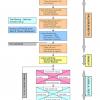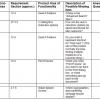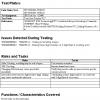|
|
Multi-user, Multi-process Test Automation There is a saying about how to make software: First you make it work; then you make it good; then you make it fast. If you have working test automation, and if your test automation is finding bugs, then the next step is to make your tests run fast. This article talks about handling two things you will need to address to make that happen: users and processes.
|
|
 |
Requirements Engineering: Our Best Practices This article focuses on a methodology adopted during a requirements and functional specification phase of a project. The chosen model for requirements engineering was founded on a combination of six sigma techniques and a set of best practices adopted from within the organization.
|
|
|
|
Agile Strategies for Geographically Distributed Quality Management Geographically Distributed Development (GDD) is a common strategy in the software world today. Organizations are gaining experience in developing software globally and are discovering that the competitive demand for best-in-class, high quality applications requires greater agility in quality management. Unfortunately, IT budgets are not keeping up with the staff required for quality management and the response is to accelerate quality management by leveraging global teams. This article compares and contrasts agile GDD testing strategies for affecting quality management.
|
|
|
|
Don't Let the Engine Run out of Fuel Clarke Ching's friend Gary is one of those quietly clever people who hated school, so he left as soon as he could to go work in a factory. Nowadays, years after their schoolboy days in New Zealand, Clarke works in Europe as a management consultant and Gary owns and runs a small farm in New Zealand. Their lives couldn't be more different, yet Gary taught Clarke one of the most valuable lessons Clarke has learned during his career. In this article, Clarke describes that lesson and how it has changed his approach toward dealing with customers and key players in developing a product.
|
|
 |
Capturing Implied Requirements Sometimes the user, project sponsor, and other key stakeholders haven't provided in the requirements documentation all the expectations of the software you're building. Instead, these expectations are only implied. In a perfect requirements-gathering process, there would be no such thing as an "implied requirement" because every requirement would be captured in the document. But no process is perfect, in theory or in practice. This article should help you look for and recognize the presence of implied requirements and learn how to capture them and convert them to documented requirements.
|
|
 |
Using Earned Value Management for Improving Processes This article explains earned value management and explores how the metric can be used to improve project and business processes.
|
|
|
|
Automatic Metrics: Turn Down the Volume and Increase Awareness Linda Hayes has always found software development metrics to be problematic. The data either skews perceptions of the project or the actions of the team members. In this article, Linda explains that by turning down the volume of what is being said and measured and simply watching what is actually happening, you can strip away the assumptions and biases that often obscure the truth.
|
|
|
|
Interoperate or Integrate Most of the organizations in today's world have some legacy software or systems. With pressures coming from outsourcing and cost-cutting, new applications are constantly being added to existing IT frameworks. In most cases, it is risky to completely replace the existing systems. As a result, most places have complex applications and systems frameworks. In order to achieve a successful coexistence of several applications on different platforms and technology architecture, teams are faced with some major questions, such as "Should we interoperate or integrate?"
|
|
|
|
Sequencing the Software Product Build-Out Because so much of what we do in software and project management is abstract, metaphors are particularly important communication tools. When I heard Peopleware author Tim Lister describe reducing project scope as "throwing cargo overboard," I adopted it immediately. If you are worried about getting to port on time with the fuel available, consider throwing low-value or optional cargo overboard; your voyage might still be considered an overall success.
|
|
 |
Test Notes and Coverage Maps--Aids for Rapid Testing As delivery cycles get shorter, rapid test techniques are gaining in popularity. In this article, Sridhar Kasibhatla and Andrew Robins explore the concept of using coverage maps and test notes to support exploratory testing and concurrent test design. These maps and test notes also are used to review and track test coverage and can help document dynamically generated test cases for future re-use.
|
|

